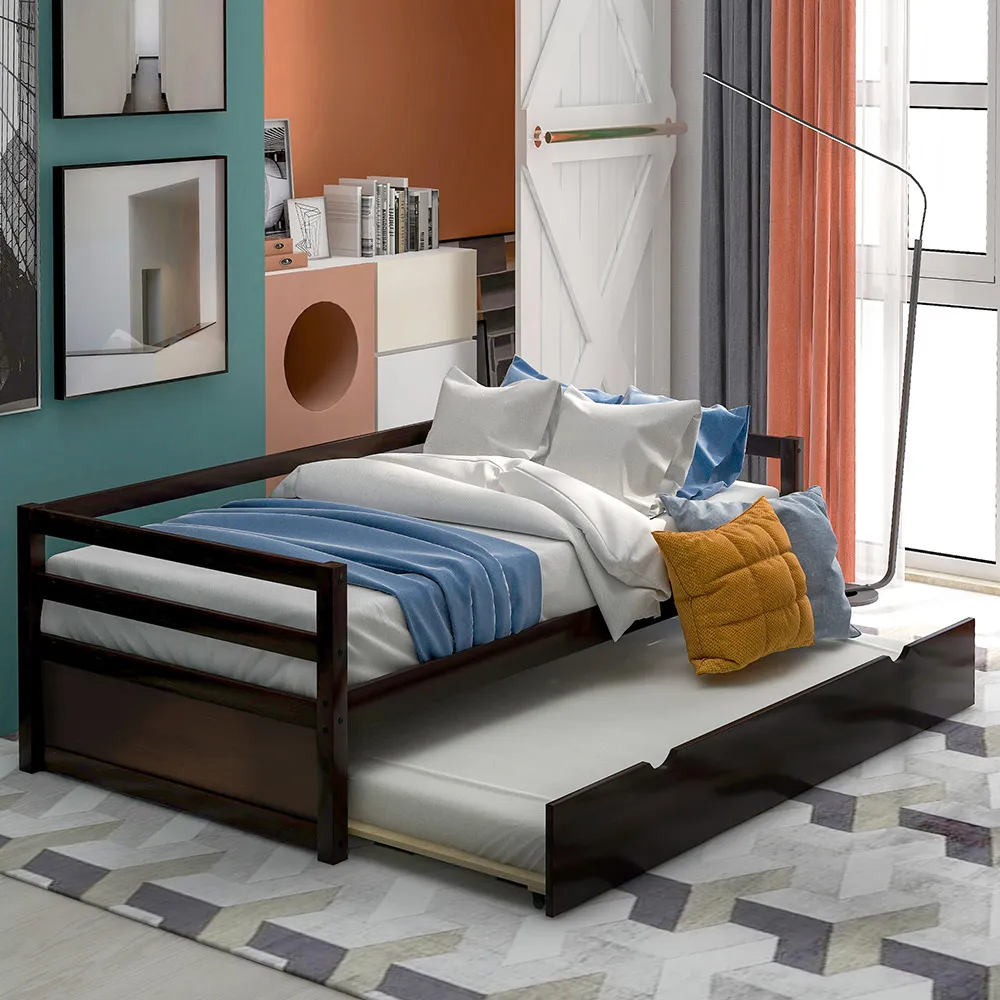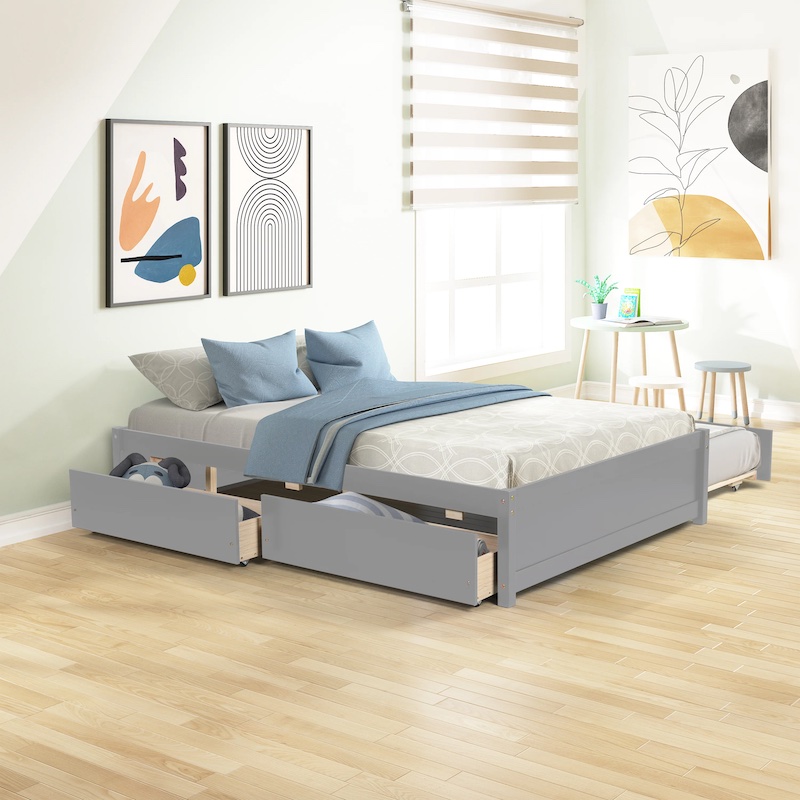Introduction
Choosing the perfect mattress size is a crucial step in creating a comfortable and functional sleeping environment. For many, the decision often comes down to two popular options: twin and full-size mattresses. Understanding the differences in dimensions, intended use, and space requirements can help you make an informed decision tailored to your individual needs. Let’s dive into the specifics of each size to guide you towards the ideal choice.
Twin Mattress Overview:
- Dimensions: A standard twin mattress measures approximately 38 inches wide by 75 inches long. This compact size is suitable for single sleepers, particularly children and teenagers. It’s also a common choice for guest rooms and small spaces.
- Space Efficiency: Due to its smaller footprint, a twin mattress easily fits into tight areas, making it an excellent option for rooms where space is at a premium. It leaves ample room for additional furniture or play areas in a child’s bedroom.
- Cost-Effective: Generally, twin mattresses are less expensive than larger sizes due to the lesser amount of materials required. This makes them a budget-friendly choice for families and those furnishing on a limited budget.
- Bedding and Accessories: Twin-sized bedding and accessories are widely available and often more affordable compared to larger sizes.
Full Mattress Overview:
- Dimensions: Also known as a double bed, a full-size mattress measures around 54 inches wide by 75 inches long. It offers an additional 16 inches in width compared to a twin, providing more room for single sleepers or accommodating a couple.
- Versatility: While a full mattress may be a tight fit for two adults, it’s an excellent choice for single sleepers who enjoy more space or for co-sleeping with a child or pet. It’s also a popular option for guest rooms where occasional adult couples might stay.
- Comfort and Spreading Out: The extra width allows for more movement during sleep, making it a comfortable choice for individuals who toss and turn or for those who simply prefer a roomier bed.
- Bedding Considerations: Full-sized bedding is more costly and less common than twin, but still widely available. Ensure to account for this when budgeting for your new mattress setup.
Key Factors to Consider:
Room Size:
Measure your bedroom carefully to ensure the selected mattress fits comfortably with enough space for movement and other furniture.
Sleeping Habits:
Consider your personal sleeping style and whether you share the bed. More active sleepers or couples may find a full-size mattress more accommodating.
Future Needs:
Think about potential future changes like growing children or moving to a different home, which could impact the suitability of your mattress size choice.
Budget:
Larger mattresses typically cost more upfront, along with associated bedding and accessories. Factor this into your decision-making process.
Long-Term Comfort:
Prioritize comfort that aligns with your body’s needs. Test out mattresses if possible and consider long-term support and durability.
Ultimately, whether a twin or full mattress is right for you depends on your unique circumstances. If space is limited, and you’re shopping for a single sleeper, a twin might be the perfect fit. Conversely, if you’re after more room for yourself or occasionally accommodate a partner, upgrading to a full-size mattress might be worth the investment. By weighing the pros and cons of each option against your specific needs and preferences, you can make a confident decision that leads to restful nights and sweet dreams.
Guest Room Considerations:
When outfitting a guest room, think about the typical guests you host. If you often have single visitors or children staying over, a twin mattress might suffice. However, if you entertain couples or want to offer a more luxurious feel, a full-size mattress will provide that added comfort and space, enhancing their experience.
Mattress Support and Foundation:
Remember that both twin and full mattresses require appropriate support. Twin beds generally fit standard twin frames, bunk beds, or daybeds, while full-size mattresses require a larger frame or foundation. Ensure that your bedroom furniture can accommodate the chosen mattress size or plan to invest in new supports if necessary.
5-Year Plan:
Reflect on your living situation over the next few years. Are you likely to move, potentially to a smaller or larger space? Are there any significant life changes on the horizon, such as having children or elderly parents moving in? Anticipating these changes can help guide your decision towards a mattress size that will serve you well in the long run.
2-Person Usage:
While a full mattress can technically accommodate two average-sized adults, it might not be the most comfortable option for nightly use. Couples might find themselves feeling cramped, leading to disturbed sleep. If sharing the bed with another person is a regular occurrence, it might be wise to consider a queen or king-size mattress for optimal comfort.
Accessibility and Room Design:
Think about how the mattress size will affect accessibility within the room. A larger bed might block walkways or make it challenging to arrange furniture in a way that promotes good traffic flow. In smaller rooms, a twin mattress can leave more open space, making the room feel more spacious and easier to navigate.
Storage Options:
In rooms where storage is at a premium, consider how the mattress size impacts your ability to incorporate storage solutions. Under-bed storage containers, for example, might fit better under a twin bed due to its lower profile.
Guest Room Considerations:
When outfitting a guest room, think about the typical guests you host. If you often have single visitors or children staying over, a twin mattress might suffice. However, if you entertain couples or want to offer a more luxurious feel, a full-size mattress will provide that added comfort and space. Remember, a comfortable guest experience can greatly enhance their visit.
Bed Frame Compatibility:
Ensure your chosen mattress size matches your existing bed frame or the one you plan to purchase. Twin beds require twin frames, while full mattresses need full-sized frames. Additionally, consider the height of the bed frame and how it might affect the overall aesthetic and ease of getting in and out of bed, especially for children or older individuals.
Health and Sleep Quality:
Sleep quality is closely tied to overall health. If you or your family member has special health considerations such as back pain or sleep disorders, a larger mattress like a full might provide better support for comfortable sleep positions. Adequate space can reduce disruptions caused by movement during the night, promoting deeper sleep.
A twin mattress, also known as a single mattress, is the smallest standard size mattress available. It measures approximately 38 inches wide and 74-75 inches long. Twin mattresses are often used for children’s bedrooms, guest rooms, or in rooms with limited space. They provide a comfortable sleeping surface for one person.
On the other hand, a full mattress, also known as a double mattress, is larger than a twin mattress. It measures approximately 54 inches wide and 74-75 inches long. A full mattress provides more width, allowing for more room to stretch and move around during sleep. They are often used in guest rooms or for teenagers and young adults who prefer a bit more space.
When choosing between a twin and a full mattress, it is important to consider factors like the size of the room, the body size of the person/people using the mattress, and personal preference for sleeping space. Twin mattresses are more suitable for smaller rooms or for single sleepers, while full mattresses provide more room for couples or sleepers who prefer extra space.
Both twin and full mattresses come in various materials, such as memory foam, innerspring, latex, or hybrid constructions, each with their own features and benefits. It is recommended to try out mattresses in person or read reviews to find the one that best suits your comfort and support needs.
Conclusion
The decision of full vs twin mattress goes beyond just the size difference; it’s about optimizing comfort, practicality, and the overall functionality of your living space. By taking into account factors such as room dimensions, anticipated usage, future plans, and your budget, you’ll be well-equipped to select the mattress size that best suits your lifestyle. Remember, a good night’s sleep is invaluable, and the right mattress size plays a significant role in achieving that. Invest wisely in a mattress that caters to your current and foreseeable needs, ensuring a comfortable and rejuvenating sleep experience every night.
There are a few other considerations when choosing between a twin and full mattress. Price is one factor, as twin mattresses tend to be more affordable compared to full mattresses in 2024. The available bedding, such as sheets and blankets, should also be taken into account, as twin bedding is easier to find and often more affordable. The amount of space available in the bedroom is another important factor to consider, as a full mattress will take up more floor space.




